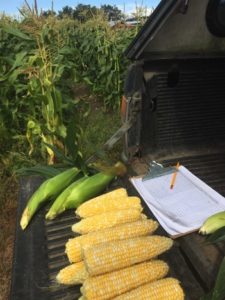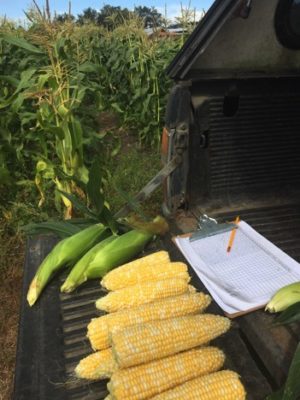Sweet Corn Seed Production: Quick Reference - Organic Seed Alliance

Common Sweet Corn Endosperm Types
| Endosperm type | Gene | Description |
| Sugary | su1 | Normal or old fashioned sweet corn, creamy texture, low sugars |
| Sugary enhancer | su1/se1 | Increased sugar and tenderness compared to sugary |
| Supersweet | sh2 | Very high sugars, hold sugars in the field and on the shelf compared to other types, often less tender |
Production
Sweet corn is highly outcrossing and wind pollinated. It is monoecious, possessing separate male (tassels) and female (silks) flowers on single plants. It is a long season crop, requiring up to 120 days for fully mature seed. Warm, dry weather is needed during seed dry down and adequate water supply is important during seed maturation and ear development (after pollination). During pollination, high daytime (80-92°F) and nighttime (65-72°F) are best. Sweet corn likes fertile, well balanced soils. Because sweet corn is highly outcrossing, at least 200 plants should be planted to maintain a population. To maximize pollination, direct seeded in a square with 8-12 inches between plants and 30-40 inches between rows. If growing more than one variety, isolate based on endosperm types (su, se, sh2). If the varieties are of the same endosperm type (e.g., se and se), 650 feet between them is enough. If the varieties have different endosperm types (e.g., su and se), double that to 1300 feet between varieties. Sweet corn seed is ready to harvest when the husks are brown, generally this is about 40 days after the silks emerge. Remove the husks and dry the ears on screens at 70-100°F. Keep good circulation and don’t keep the ears at this high heat beyond drying. Once the seed is fully dry (very hard and cannot be dented with a fingernail), shell it using a hand crank sheller or by hand. Screen and winnow the seed to remove chaff and small and immature seed. Seed dried to 8.0% or less moisture can be stored at 40-60°F and 40%RH or less for 1-3 years.
Selection and Variety Improvement
Traits that can be selected for prior to pollination, such as for germination, vigor, and plant stature will increase the effectiveness of selection. Selections made after pollination, such as for ear qualities such as flavor, row straightness, tip fill, yield, and wrapper leaves and husk quality, will still make progress, but it will be slower than selections made before pollination. This is because pollen from undesirable/unselected plants will have contributed to pollination and fertilization of selected plants. This can be avoided by using a family selection method and remnant seed rather than mass selection (see the following OSA guides: “Introduction to On-farm Organic Plant Breeding” and “How to Breed Sweet Corn for Organic Agriculture”).

| Trait | Timing |
| Soil emergence | After planting |
| Seedling vigor | After planting |
| Date of first pollen shed | |
| Date of first emerging silks | |
| Incidence of foliar diseases | Throughout season |
| Incidence of lodging | Before pollination |
| Plant height | Before pollination |
| Tassel color | At flowering |
| Stalk color | Before pollination |
| Husk color | Market harvest |
| Ear height on plant | Market harvest |
| Ear length | Market harvest |
| Ear diameter | Market harvest |
| Ear shape | Market harvest |
| Incidence of corn earworm | Market harvest |
| Date of first ears suitable for fresh eating | Market harvest |
| Date of first mature seed | Seed harvest |
| Endosperm type – flour, flint, dent, popcorn, sweet (su, se, sh2) | Market harvest, seed harvest |
| Kernel color | Market harvest, seed harvest |
| Ear fill | Market harvest, seed harvest |
| Tip fill | Market harvest, seed harvest |
| # rows per ear | Market harvest, seed harvest |
| Straightness of rows | Market harvest, seed harvest |
| Kernel texture | Market harvest |
| Kernel tenderness | Market harvest |
| Kernel flavor | Market harvest |
| Kernel sweetness | Market harvest |
Disease
Use resistant varieties when available. Practice 3-5 year crop rotations. Maintain adequate levels of Nitrogen and Phosphorus to reduce nutrient stress and improve crop growth. Bury old crop residues that may harbor pathogens. Minimize water stress at flowering. Harvest ears with good wrapper leaves and no or only minimal husk damage. Harvest ears as early and timely as possible to reduce the risk of moldy kernels. Dry ears as quickly as possible to 15% and monitor kernel moisture periodically throughout storage. Clean kernel thoroughly with winnowing and screening before storing. Protect kernels from insects and rodents. Diseases are classified by severity with a class of 1 being the most severe and 3 the least severe.
| Disease | Type | Severity class | Favorable conditions |
| Black bundle disease (Acremonium strictum) |
Seedborne | 3 | Post flowering water stress |
| Southern leaf blight (Helminthosporium maydis) |
Seedborne | 3 | Warm & humid |
| Black kernel rot (Botryodiplodia theobromae) |
Seedborne | 3 | Wet weather just after silking |
| Goss’s bacterial blight & wilt (Clavibacter michiganensis subsp. nebraskensis) |
Seedborne | 3 | Continuous corn production; reduced tillage; hot and humid |
| Anthracnose (Collettotrichum graminicola) |
Seedborne | 2 | High temperature and extended wet periods |
| Fusarium diseases (Fusarium spp.) |
Seedborne | 3 | Warm & dry |
| Northern corn leaf spot (Helminthosporium carbonum) |
Seedborne | 3 | Warm & high humidity |
| Charcoal rot (Macrophomina phaseolina) |
Seedborne | 3 | Warm (80-85°F) and dry |
| Maize dwarf mosaic virus (MDMV) | Seedborne | 3 | Proximity to johnsongrass |
| Seedling blight (Penicillium spp.) |
Seedborne | 3 | Cool, wet, poorly drained soils |
| Downy mildew (Peronosclerospora sorghi) |
Seedborne | 3 | High humidity & moderate temperature |
| Head smut (Sporisorium holci-sorghi) |
Seedborne | 3 | Temperature between 70-82°F and low soil moisture |
| Ear rot; stalk rot; seedling blight (Stenocarpella macrospora, S. maydis) |
Foliar | Hot & humid just after silking |
This resource was made possible thanks to the Montana Department of Agriculture’s Specialty Crop Block Grant Program.

